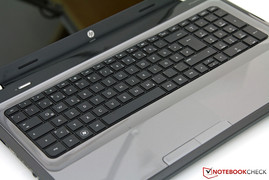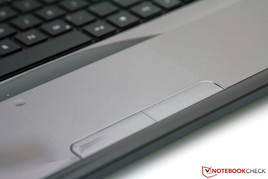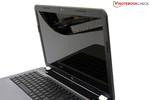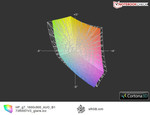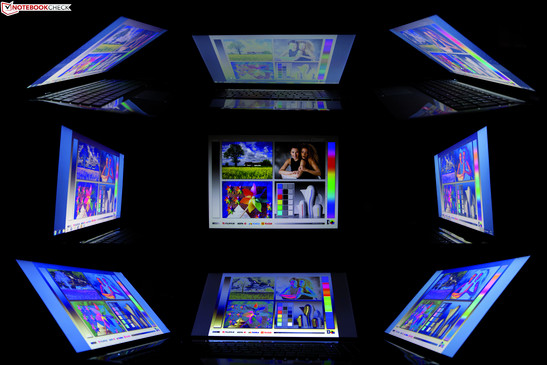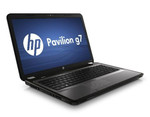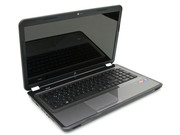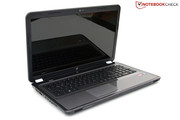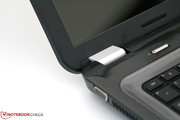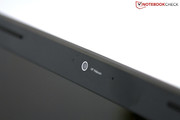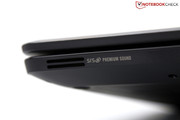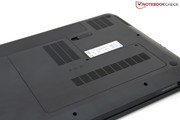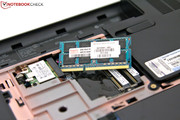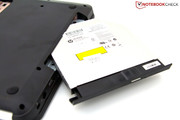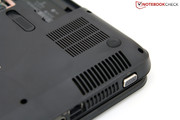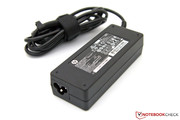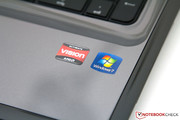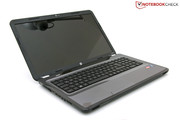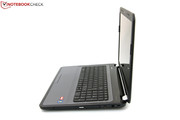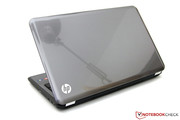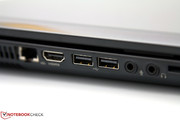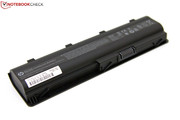Review HP Pavilion g7-1002sg Notebook

An abundance of various models—24 to be exact—make up the new HP Pavilion g7-1000 notebook series. Its 17.3" display with a glossy screen and native resolution of 1600 x 900 pixels (HD+) will be the first thing you notice. The series also uses the well-known case design, which finds use in the HP Pavilion g6-1141sg as well. The sheer variety of models means the hardware selection is nearly unrestricted. In addition to the older Intel Core processors, the g7 is also available with the newer Intel Sandy Bridge CPUs and even AMD processors.
The HP Pavilion g7-1002sg we reviewed, is equipped with an AMD Phenom II X4 P960 quad-core processor, running at a clock rate of 1.8 GHz, 4 GB DDR3 RAM, a 750 GB hard drive and a dedicated AMD Radeon HD 6470M graphics card. Sounds expensive? It's not! This particular model as well as others start as low as 499 Euro (RRP) including VAT.
Case
Silver and black, the key ingredients of a timeless design. The entire case consists of plastic, which leaves a decent impression. The glossy surfaces are sleek on the one hand but collect dust and fingerprint marks on the other. Interestingly enough, the display bezel is one of the few surfaces having a matte finish. This aspect in particular gives the design a kind of thrown-together look, which thanks to the three different colors does not look dull. A closer inspection of the case reveals no big flaws in craftsmanship. The choice of materials and feel of the notebook are typical for the Hewlett Packard g-series.
We can only describe the sturdiness of the case as average. Upon pressing hard in on the case, it dents temporarily and the keyboard bounces a bit when pushed hard. It's a similar story with the display lid, which is easily dented and twisted. The shiny metal display hinges leave the impression of quality and indeed hold the display lid well in place. The display lid does still bob back and forth a bit after being adjusted, however.
The most important hardware is accessible after removing an L-shaped maintenance hatch located on the base plate and attached to it by just two screws. Next to the wifi card we find two RAM slots (max 8 GB) as well as the hard drive, which can measure no more than 9.5 mm in height in this laptop.
Connectivity
We find here the usual, modest variety of ports, taken from the smaller Pavilion g6-1141sg, although we had hoped that HP would have expanded upon modest selection of ports. In addition to two USB 2.0 ports, we have HDMI and a card reader, for instance. We like the positioning of ports for the most part. The majority of the ports are found at either side toward the back, while the front and rear edges remain smooth without any ports whatsoever. Considering the price, this is pretty good, but a USB 3.0 port would really have topped off the package nicely.
Internet and Bluetooth
Connectivity is restricted to what you'd expect from this price range. Bluetooth 3.0 +HS and a 3G-UMTS are unavailable, although you can still make use of these features given the appropriate USB dongle. Besides that, we do find the usual Realtek gigabit Ethernet as well as Draft-N wifi (802.11n) from Broadcom.
Accessories
The included accessories are few. Besides the actual laptop, you'll find a 90-watt power supply with cable, a 6-cell battery with a capacity 47 Wh as well as various documentation. HP does offer other goodies at a price. Among these are batteries, warranty extensions, hard drives, carrying sleeves and much more. Most of these products are also available from third-party retailers, so shopping around is definitely a good idea. The pre-installed software found on the system leaves a similar impression. Aside from Office 2010 Starter and Adobe Reader 9, there are few useful programs. Applications you deem unnecessary should be uninstalled to make space and keep the system running quickly.
Warranty
The HP warranty in the case of the Pavilion g7's tends to differ in terms of how long it lasts. The smaller models come with only a 12-month warranty including pickup and return service. Few models, including the one reviewed here, come with a 24-month service warranty, which can be extended to a maximum of 48 months at an additional cost.
Input Devices
Keyboard
Hewlett Packard has stayed true its established look and feel, giving the Pavilion g7 the traditional design in full. The base of each key is recessed and slightly rounded, making the entire layout look like a smooth, carefully put-together jigsaw puzzle. The keys themselves measure 15 x 15 mm each, making it quite easy to type accurately. The top row of keys as well as the arrow keys aren't as tall, however. The dedicated number pad is full-sized and would give off the impression of high-class business if it weren't for the cheap look of its plastic keys. The feel of typing is a bit unusual due to the short depression depth of the keys and can be uncomfortable during extended periods of use, especially considering the noisy clatter of the keys. Compared to more expensive models, like the EliteBooks, the difference in quality is all the more noticeable.
Touchpad
The V7.5 Touchpad from Synaptics is seamlessly integrated in the surrounding palm rest but can be felt out thanks to its pimpled surface. This slightly rough surface makes navigating the cursor easy, but there's not enough of a boundary between it and the surrounding area. The multitouch gestures make use even quicker and easier—a video tutorial is available in the touchpad settings menu. For the most part, all the gestures work smoothly but you have to be patient and wait a little sometimes until the system responds to the gesture. Below the touchpad we find the two touchpad buttons, which get the job done, but similar to the keyboard sound and feel a bit shabby.
The HP Pavilion g7 series' trademark characteristic is its glossy 17.3" screen (43.9 cm). The high resolution of 1600 x 900 pixels at an aspect ratio of 16:9 is excellent for office and multimedia applications, even though pricier laptops have full-HD screens (1920 x 1080 pixels). Unfortunately, the HP doesn't offer a full-HD display or the option of a matte screen. For more detailed resolutions, the laptop can be hooked up to an external monitor/TV via VGA or HDMI. The picture quality is then crystal clear, although you might have to manually adjust how the picture fits on the external monitor.
Those basic specs aside, we now take a closer look at this AUO panel, model number B173RW01 V3. The maximum screen brightness of 214 cd/m² is nothing more than average. Fortunately, the screen is incredibly evenly lit at a 94% brightness distribution. This model is luckily unaffected by clouding of LEDs or poor brightness distribution that often plagues its competitors of the same price range.
| |||||||||||||||||||||||||
Brightness Distribution: 94 %
Center on Battery: 212 cd/m²
Contrast: 193:1 (Black: 1.1 cd/m²)
Other measurements we took only confirm this picture of a mediocre display. The black level is a bit too high at 1.1 cd/m², making blacks appear more gray and bringing down the contrast to a low 193:1. High picture contrast is most important in making films appear more vivid and enjoyable to watch. For other purposes, the colors and sharpness of the picture are perfectly fine and will likely go unnoticed.
We didn't expect the Pavillion to display a very broad range of colors. Still, the image at the right here shows that the HP's color space here covers a good deal of the sRGB reference color space. This means, the notebook is not terrible for a professional applications like image processing.
Outdoors, the notebook can't quite overcome the reflective rays of the sun. The screen brightness would otherwise have been high enough if it weren't for the glossy screen that makes the display more of a mirror than a computer screen.
Finally, the range of viewing angles confirms our suspicious about this being a cheap TN panel. Looking at the screen from the left or the right, the picture remains discernible for viewing angles up to 45º away from the ideal. Vertically, this happens much faster. Even a small tilt away from the ideal position results in color inversion or an over-exposed looking picture (see image below). Get a better impression of this phenomenon by watching the video below.
Performance
The hardware within the g7 is not limited by much except for your own imagination. The ample selection of CPUs allows you to extensively customize to match your needs. In addition to older Intel CPUs, AMD processors as well as Intel's new line of Sandy Bridge processors are available for the g7. The model we reviewed is equipped with an AMD Phenom II X4 P960 quad-core processor. Running at a base clock rate of 1.8 GHz with only a 2 MB L2-cache it can be considered an inexpensive (but relatively weak) option for multi-core processing. If you're looking for more power, the new Sandy Bridge CPUs—which are manufactured via the ultramodern 32 nm process—might be the way to go with their speedy data retrieval from L3 cache. The AMD Phenom processor—found in the particular configuration we're reviewing here—only manages a performance on par with the previous generation of Intel's mobile CPUs, however.
Moving on to the graphics card, things get a little more interesting. In addition to the on-board AMD Radeon HD 4250 graphics card, we also find the AMD Radeon HD 6470M dedicated graphics card with 1 GB RAM. With 160 stream processors, UVD3 video decoder and DirectX 11 support, this GPU proudly sports the latest graphics technology. The manual graphics card switching is not the most convenient way to achieve a good balance between energy efficiency and powerful graphics rendering. In the Catalyst Control Center, you can switch between which of the two GPUs is active. The new AMD PowerXpress 4.0 aka BACON (automatic switchable graphics) is not installed. But since BACON is still little more than a prototype, it's probably a good thing you have to manually switch graphics cards—which functions flawlessly by the way.
The first tests we ran dealt with the performance of the processor. The single-core performance is particularly limited due to the lack of a L3-cache. The CineBench R10 (64-Bit) benchmark from Maxon only confirms this. Earning a mere 1922 points, the CPU in place here ranks in within the bottom third of our entire database. A very similar score is produced by the Intel Core i3-330M. The current mainstream model, the Core i5-2410M, runs 57.2% more quickly at 4493 points. In the Multi-Thread Rendering, the AMD processor here picks up the pace and places closer to average with 6649 points. The new AMD Llano APU A6-3410MX in the HP Pavilion dv6-6110eg earns 7198 points (+ 7.6 %). The dual-core i5 alternative is even faster (+ 29,9 %). Even Intel's current starter model from Intel, the Core i3-2310M, is a bit faster than the P960 (+ 9.3 %).
| 3DMark 03 Standard | 10918 points | |
| 3DMark 05 Standard | 7140 points | |
| 3DMark 06 Standard Score | 3940 points | |
| 3DMark Vantage P Result | 1618 points | |
| 3DMark 11 Performance | 548 points | |
Help | ||
The graphics card here (Radeon HD 6470M) represents AMDs entry-level dedicated GPU. Earning 3940 points in the classic 3DMark 06 benchmark, we see it's performance comes out about average. What's interesting is that the on-board Intel GMA HD 3000 graphics card actually scores better when installed in some notebooks (e.g. Lenovo IdeaPad Z370, 4589 points, +20.7%). On average, however, the Intel GPU earns 3649 points, placing it 7.4% behind AMD's dedicated GPU. An alternative to consider would be the APUs from AMD available for laptops. The AMD A6-3410MX with a Radeon HD 6755G2 GPU earns 7380 points, making it around 46.6% faster. Impressive as it is, the cost of such a laptop might be a deal breaker.
In the current 3DMark 11 benchmark, the high demands of DirectX 11 graphics rendering leave the Radeon HD with a mere 493 points, that is, toward the very end of the database. Similar in performance is the Nvidia GeForce GT 520M, making it the 6470M's main rival. All in all, the hardware should suffice for decent office performance and low-intensity multimedia use. For recent games, however, you really need a better graphics card to produce a decent picture and frame rate. Games only run smoothly with lower resolutions and and set to fewer graphics details.
| PCMark Vantage Result | 3999 points | |
| PCMark 7 Score | 1396 points | |
Help | ||
The overall system benchmark from Futuremark ends the round of hardware testing. Achieving an overall score of 3999 points, the laptop ranks in below average in the PCMark Vantage benchmark. Next to the processor and graphics card, the other hardware doesn't help bring the score up either. The slow hard drive has quite a negative effect. Only notebooks with older hardware rank this low in our database. In comparison, Intel Sandy Bridge processors and AMD Llano APUs contribute to much higher scores here.
The hard drive here isn't exactly top of the line. Luckily, the Hitachi HDD has a large storage capacity of 750 GB. The Travelstar 5K750 (model no. HTS547575A9E384) with rotational speed of 5400 RPM is connected via a SATA II channel. At a maximum data transfer rate of 89 to 101 MB/s (read score, varies with benchmark) and the expectedly slow access time (19.6 ms), the hard drive is nothing more than average. A hybrid drive (SSH) or simply a solid state drive (SSD) would do wonders for the access times. The problem with older Intel hardware and the AMD hardware in place here is the lack of support for a SATA III connection (needed for speedy new SSDs).
Fortunately, there are configurations of the HP g7 with the new Intel Sandy Bridge CPUs and SATA III support available, which show similar performance but cost a bit more than the laptop configuration reviewed here.
Verdict: Gaming
Taking a look at previous reviews and the article "Computer Games on Laptop Graphics Cards" found in the FAQ/Tips section of the website, you can see that the AMD Radeon HD 6470M is not very well suited for gaming. For example, the first-person shooter Crysis 2 is only playable in low resolutions and moderate graphics settings. Graphically less demanding games like the football classic FIFA 11 or the MMORPG World of Warcraft still run smoothly with the graphics settings set to max. The GPU is, therefore, ok for playing games that aren't incredibly recent of graphics-intensive.
Emissions
System Noise
Although the size of the laptop might prevent you from carrying it around everywhere, it should allow the system to stay cool with a minimum of noise. That's unfortunately not the case. The single exhaust fan, DVD drive and hard drive all do their part to "bring the noise". As soon as the fan starts spinning (when the system is idle) a noticeable 34.1 dB(A) is produced. On top of the constantly running fan, the Hitachi HDD should really be quieter. Producing an elevated noise level of 35.5 dB(A), the hard drive makes an irritating clickity-clack sound when retrieving data.
Under heavy use, the noise level rises to a maximum of 39.1 dB(A). Even in this case, the HDD is the thing making the most noise. At times we measured levels as astoundingly high as 54 dB(A), making for quite an irritating clicking noise—which may just be a defect in this one HDD in laptop we received and might not reflect what retail models will sound like.
Noise level
| Idle |
| 32.4 / 34 / 34.1 dB(A) |
| HDD |
| 35.5 dB(A) |
| DVD |
| 36.3 / dB(A) |
| Load |
| 36.6 / 39.1 dB(A) |
 | ||
30 dB silent 40 dB(A) audible 50 dB(A) loud |
||
min: | ||
Temperature
You'd think the large case and fairly loud fan would do a good job of keeping the case surface cool. This is fortunately true while the laptop is idle, with temperatures only reaching a relatively cool (lukewarm) 31.5ºC, leaving no room for complaints. However, under heavy use the case gets a good deal warmer. The area around the keyboard becomes noticeably warm, which doesn't leave the temperature of the keyboard itself unaffected. Holding the notebook on your lap may become uncomfortable as the bottom of the case reaches a maximum of 39.2ºC near the exhaust vent. Although these temperatures could stand to be lower, they're not horribly uncomfortable. The smaller Pavilion g6-1141sg has even worse problems with case temperature.
(+) The maximum temperature on the upper side is 36.7 °C / 98 F, compared to the average of 36.9 °C / 98 F, ranging from 21.1 to 71 °C for the class Multimedia.
(+) The bottom heats up to a maximum of 39.2 °C / 103 F, compared to the average of 39.2 °C / 103 F
(+) In idle usage, the average temperature for the upper side is 25.9 °C / 79 F, compared to the device average of 31.3 °C / 88 F.
(+) The palmrests and touchpad are cooler than skin temperature with a maximum of 31.5 °C / 88.7 F and are therefore cool to the touch.
(-) The average temperature of the palmrest area of similar devices was 28.7 °C / 83.7 F (-2.8 °C / -5 F).
Speakers
For your listening pleasure, there are two stereo speakers located toward either end of the front edge of the laptop. Next to the slit-like speakers you'll find written "Altec Lansing" and "SRS Premium Sound". As we found out, this does not mean the actual sound quality is anything special. The high notes sound pretty natural and even the bass is present to an extent. The range of frequencies is not too full, though, and the audio produced isn't extremely enjoyable. We'd say these speakers are slightly above average as far as laptops go. In comparison, the Dell Vostro 3750 produces excellent sound quality thanks in part to its built-in subwoofer. However, hooking up some good speakers or headphones via the 3.5mm audio jack or the HDMI-output will definitely produce some premium sound quality.
Battery Life
With the processor and graphics card demanding a good deal of power, the laptop is not incredibly energy-efficient. While idle (using only the on-board GPU), the power consumption reaches an elevated 25.9 watts. Under heavy use, the AMD Radeon HD 6470M together with the processor drives up the energy consumption level a good deal. The maximum power consumption of 69.6 watts is moderate and expected for this configuration. The power supply can easily handle this, being designed to handle up to 90 watts.
| Off / Standby | |
| Idle | |
| Load |
|
Key:
min: | |
Battery Life
The 6-cell battery with a capacity of 47 watt-hours based on Lithium-ion technology would be expected to give the laptop a more-than-decent battery life. Unfortunately, here too the g7 falls below expectations. Using the BatteryEater Classic Test, we measured the shortest possible battery life. With screen brightness all the way up and wifi on, the laptop held out on battery power for a mere 63 minutes. The other extreme is represented by the Reader’s Test (simulates reading a document on the screen) with wifi off and minimum screen brightness. At 3 hours 46 minutes, this is pretty disappointing "longest possible battery life" that'll force you to carry around the power supply with you just about everywhere you go. Representing more typical everyday use we have the "Internet browsing via wifi" test. After a short 2 hours 12 minutes with moderate screen brightness, the battery ran out of juice. All in all, not a very impressive performance, the laptop being highly dependent on an external power source.
Verdict
The HP Pavilion g7-1002sg is definitely marketed toward bargain hunters at a suggested retail price of only 499 Euro. In exchange, you get a laptop with a large 17.3" screen and a fair amount of choices concerning hardware, all housed in a simple plastic case. The variety of ports is acceptable and the main modes of connecting to the internet are all there. The keyboard and touchpad are rather large but feel a bit flimsy (the keyboard keys have a very short depression depth).
The performance of the AMD processor and graphics card in the configuration we tested is limited mostly to office work and light multimedia tasks. The model equipped with a Sandy Bridge dual-core processor is worth having a look at if you're looking for better CPU performance (video rendering, transcoding, etc.). The Pavillion does a poor job in terms of its system noise, cooling and battery life. All in all, the HP g7 represents a very inexpensive desktop replacement with limited mobility and some shortcomings that really could have been better dealt with.








